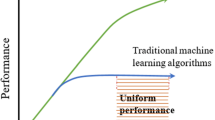Abstract
E-healthcare system based on wireless body area network (WBAN) promises to produce potential benefits in health-care industry. A major issue of such an on-body networked system is the energy efficiency, that is, how to improve the reliability and effectiveness of physiological data transmission with the energy constraints of tiny wireless sensors. Motivated by this, we consider an individual WBAN scenario, focusing on finding an adaptive time slot allocation and power control scheme to maximize the average energy efficiency for implementing the task of health monitoring. We formulate the maximization problem with latency and sensors’ energy budget constraints as a markov decision process (MDP). As a solution, we propose a deep reinforcement learning-based scheme to make a sequence decision for the MDP, which jointly optimizes power control and slot allocation. Simulation results show that the proposed scheme is energy efficient and has a good convergence.








Similar content being viewed by others
References
Movassaghi, S., Abolhasan, M., Lipman, J., Smith, D., & Jamalipour, A. (2014). Wireless body area networks: A survey. IEEE Communications Surveys & Tutorials,16(3), 1658–1686.
Salayma, M., Al-Dubai, A., Romdhani, I., & Nasser, Y. (2017). Wireless body area network (WBAN): a survey on reliability, fault tolerance, and technologies coexistence. ACM Computing Surveys (CSUR),50(1), 3.
Yazdandoost, K., & Sayrafian, K. (2009). Channel model for body area network (Ban). IEEE p802. 15-08-0780-09-0006. IEEE 802.15 working group document.
Hayajneh, T., Almashaqbeh, G., Ullah, S., & Vasilakos, A. V. (2014). A survey of wireless technologies coexistence in WBAN: analysis and open research issues. Wireless Networks,20(8), 2165–2199.
Davenport, D. (2009). Medwin physical layer proposal. IEEE 802.15 document repository. IEEE 802.15-09-0328-01-0006.
Kaur, T., & Kumar, D. (2016). TDMA-based mac protocols for wireless sensor networks: A survey and comparative analysis. In 2016 5th international conference on wireless networks and embedded systems (WECON) (pp. 1–6). IEEE.
Salayma, M., Al-Dubai, A., Romdhani, I., & Nasser, Y. (2017). New dynamic, reliable and energy efficient scheduling for wireless body area networks (WBAN). In 2017 IEEE international conference on communications (ICC) (pp. 1–6). IEEE.
Kim, S., & Eom, D. S. (2014). Link-state-estimation-based transmission power control in wireless body area networks. IEEE Journal of Biomedical Health Informatics,18(4), 1294–1302.
Goswami, D., Sarma, K. C., & Mahanta, A. (2015). Experimental determination of path loss and delay dispersion parameters for on-body UWB WBAN channel. In IEEE international conference on signal processing.
Chaganti, V. G., Hanlen, L. W., & Lamahewa, T. A. (2011). Semi-markov modeling for body area networks. In 2011 IEEE international conference on communications (ICC) (pp. 1–5). IEEE.
Li, H., Yang, B., Yu, W., Guan, X., Gong, X., & Yu, G. (2014). Joint sleep scheduling and opportunistic transmission in wireless body area networks. In The 26th Chinese control and decision conference (2014 CCDC) (pp. 1886–1891). IEEE.
Taleb, S., Hajj, H., & Dawy, Z. (2018). VCAMS: Viterbi-based context aware mobile sensing to trade-off energy and delay. IEEE Transactions on Mobile Computing,17(1), 225–242.
Li, J., Liu, Q., Wu, P., Shu, F., & Jin, S. (2018). Task offloading for UAV-based mobile edge computing via deep reinforcement learning. In 2018 IEEE/CIC international conference on communications in China (ICCC) (pp. 798–802). IEEE.
Chen, Guihong, Zhan, Yiju, Sheng, Geyi, Xiao, Liang, & Wang, Yonghua. (2019). Reinforcement learning-based sensor access control for WBANs. Access IEEE,7, 8483–8494.
Kleinrock, L. (1975). Queueing systems. Vol. I: Theory. IEEE Transactions on Communications,65(6), 990–991.
Jain, R. K., Chiu, D.-M. W., & Hawe, W. R. (1984). A quantitative measure of fairness and discrimination. Hudson, MA: Eastern Research Laboratory, Digital Equipment Corporation.
Sutton, R. S., & Barto, A. G. (2018). Reinforcement learning: An introduction. Cambridge: MIT Press.
Anschel, O., Baram, N., & Shimkin, N. (2017). Averaged-DQN: Variance reduction and stabilization for deep reinforcement learning. In Proceedings of the 34th international conference on machine learning-volume 70 (pp. 176–185). JMLR.org.
Umehira, M., Fujita, S., Gao, Z., & Wang, J. (2013). Dynamic channel assignment based on interference measurement with threshold for multibeam mobile satellite networks. In 2013 19th Asia-Pacific conference on communications (APCC) (pp. 688–692). IEEE.
Acknowledgements
Funding was provided by the Fundamental Research Funds for the Central Universities (Grant No. 30918011329).
Author information
Authors and Affiliations
Corresponding author
Additional information
Publisher's Note
Springer Nature remains neutral with regard to jurisdictional claims in published maps and institutional affiliations.
Rights and permissions
About this article
Cite this article
Wang, L., Zhang, G., Li, J. et al. Joint optimization of power control and time slot allocation for wireless body area networks via deep reinforcement learning. Wireless Netw 26, 4507–4516 (2020). https://doi.org/10.1007/s11276-020-02353-9
Published:
Issue Date:
DOI: https://doi.org/10.1007/s11276-020-02353-9




